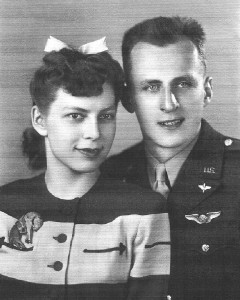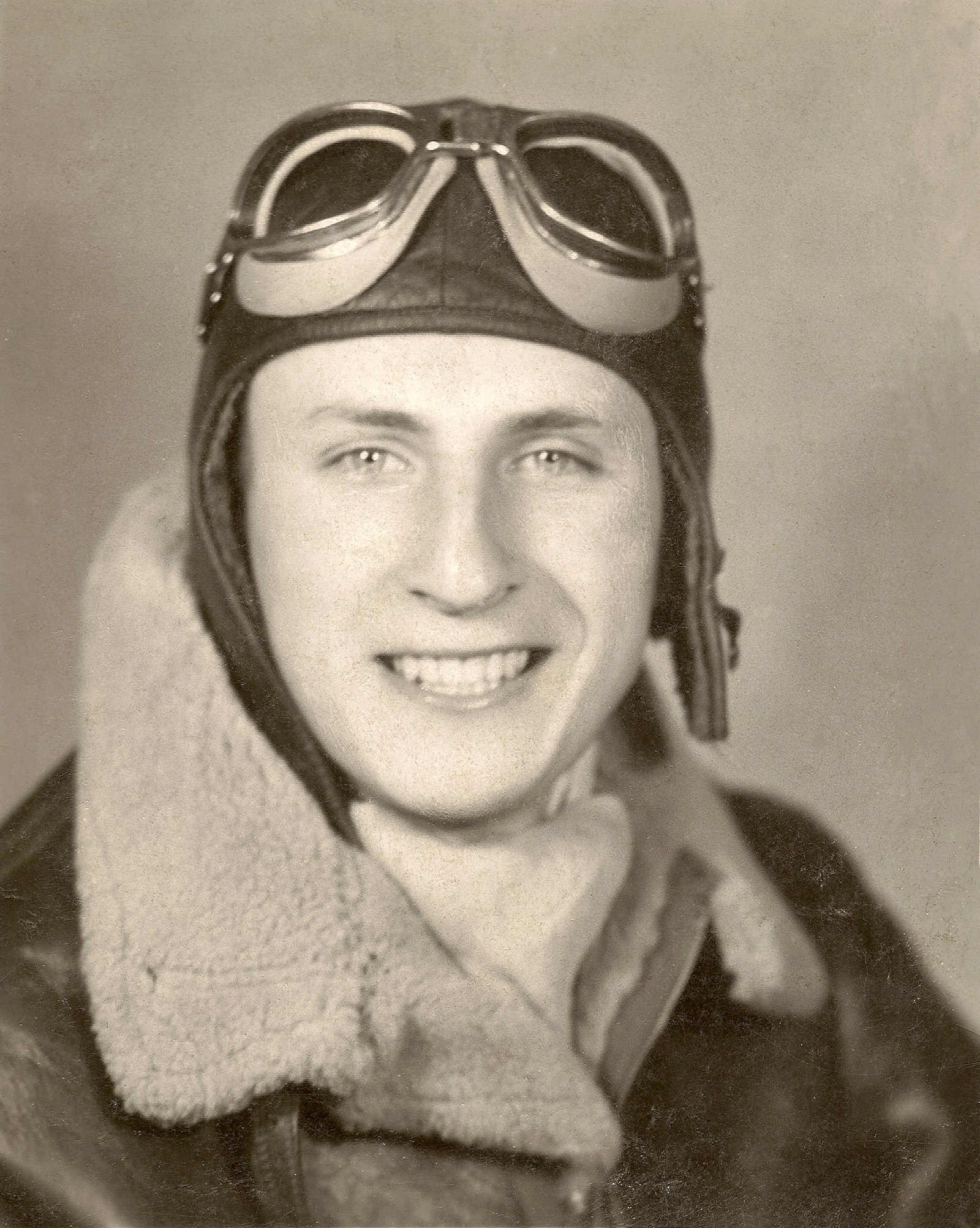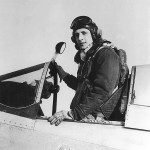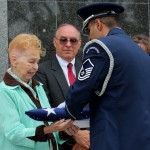By Harlis Brend
Triple Ace Ernie Bankey, Jr., flew quietly out of this world on June 10, 2009, at his home in Newbury Park, Calif. A memorial service with full military honors was held at Chapel of the Islands, Conejo Mountain Memorial Park in Camarillo, Calif., on June 15, 2009.
Ernie Bankey was born on Aug. 28, 1920, in Cleveland, Ohio. His interest in airplanes began at about age eight, and he spent many years building model airplanes. He spent his childhood summers with relatives who lived next door to the Cleveland Air Races. When Bankey graduated from high school, he wanted to fly. On April 1, 1941, Bankey put his general contracting business on hold and entered active duty service in the Army Air Corps at Ft. Hays in Columbia, Ohio.
Bankey was promoted to staff sergeant while teaching aerial gunnery in Las Vegas, Nev., during his wait to be accepted into Air Cadet School. He flew his primary training in the Stearman PT-13, basic training in the Vultee BT-13 and advanced training in the North American AT-6. Following twin-engine training in the Curtiss AT-9, he transitioned into the Lockheed P-38.
Bankey received his pilot wings and second lieutenant commission in July 1943 at Williams Air Force Base in Arizona and was assigned to the 383rd Fighter Squadron, 364th Fighter Group for gunnery and bombing training in the P-38 at Muroc (now Edwards Air Force Base), Calif. He received additional instruction in formation flying and acrobatics at Van Nuys Airdrome (now Van Nuys Airport), Calif., before being assigned to Oxnard Flight Strip (now Camarillo Airport). While at Oxnard, he received additional gunnery and bombing training and flew patrol over Los Angeles during a submarine scare.
Eventually Bankey was on his way to Europe, leaving from New York Harbor on the Queen Elizabeth in first-class accommodations. The five-day trip ended at Liverpool, England, on Feb. 5, 1944. He was stationed near Birmingham at Honington Royal Air Force Base.
Bankey’s most memorable flight was on Dec. 27, 1944, during the Battle of the Bulge. He was leading the 383rd squadron when they spotted more than 200 German aircraft below them. They dove down, broke up the flight, and Bankey scored two victories on Messerschmitt Me 109s. He continued on and spotted three Me 109 stragglers below. The leader became his third victory for the day. Deciding that he better get out of there, he climbed back up and spotted a large flight of FW-190s below. Bankey gave chase, and the FW-190 went down to treetop level. He soon realized that there were about 25 planes following him—they were German Me 109s! Bankey was alone flying between two groups of German fighters (an estimated total of 50).

Ernest E. Bankey and Lillian Ruth Kontak (Ginny) were married on May 2,1942 at Bowling green, Ohio. Although Ginny had purchased a white wedding dress for her wedding, they eloped while on a trip to Bowling Green.
That is when Bankey made his famous radio call. “This is Sunkist Two. I’ve got 50 Jerries cornered over Bonn. Will share same with any P-51s in the vicinity. See me at smokestack level. Over and out.” Help came quickly. A flight of four P-51s came down to “share.”
When the melee was over, Bankey had scored a total of five victories for the day and shared one more with another P-51. He became one of the rare “Ace-in-a-Day” fighter pilots.
Bankey headed for home, low on ammo and fuel. He landed at an Allied base in Belgium. The base commander treated him to a little Scotch, refueled his plane, and Bankey was on his way for the long flight alone to home base in England. That mission earned him the unofficial title “The Tiger of Bonn.”
According to Army Air Corps mission records, Bankey was credited with 101/2 air-destroyed, one probable, five ground-destroyed and five ground-damaged enemy aircraft. He is also credited with the destruction of 44 locomotives. Bankey flew more than 100 sorties and accumulated 500 combat hours during two tours of duty.
He was awarded the Distinguished Service Cross for his Dec. 27, 1944, mission. Additional air combat awards he earned were the Silver Star, the Distinguished Flying Cross with Cluster, Air Medal with Nine Clusters and the French Croix De Guerre with Palm.
Bankey returned to civilian life in January 1946. He worked as a general contractor until re-entering the Air Force in 1953 and being stationed in Wiesbadan, Germany, and Libya, North Africa. In August 1958, he was assigned to Vandenberg AFB, Calif., where he served as site commander for the first intercontinental ballistic missile launch into the Pacific by an Air Force crew on Sept. 19, 1959.
Bankey retired from the Air Force at SAC Headquarters, Offutt AFB, Neb., in 1968 as a colonel. He returned to California and joined Jet Propulsion Laboratories in Pasadena, working on deep space projects until his retirement in 1975.
For the past 40 years, Bankey and his wife Ginny, his “one and only for the past 67 years,” have lived in the Los Angeles area. They have two sons (Dan and Keith), two daughters (Sharon and Tina), eight grandchildren and seven great-grandchildren.
Bankey and Ginny were frequent Monday morning attendees at the “Wings Over Wendy’s” gathering of more than 70 pilots and aviation enthusiasts. Bankey often spoke to the group about his military flying adventures. The group, made up primarily of WWII pilots, bombardier/navigators and flight crews, meets every Monday morning at 9 a.m. at the Wendy’s restaurant on Platt Ave. in Woodland Hills, Calif.
At the memorial service, Rev. R. Z. Meyer characterized Bankey as “a man you couldn’t forget, even if you tried.”
He continued, “When you think of Ernie, he comes in loud and clear. He was an exceptional man with exceptional courage. He was a man with strong convictions, and he let you know them! Today we celebrate the life of a great man, and the military ceremony will celebrate his service to his country.”
- Ernie Bankey getting ready for another mission.
- Ernie Bankey with his P-51 Lucky Lady VII — The marking on the fuselage symbolized his combat victories.
- Ernie Bankey flew the T-33A.
- Ernie Bankey served as Launch Control Officer at Vandenberg AFB for ICBM tests.
- Ernie Bankey telling stories about his flying adventures at “Wings over Wendy’s”. L to R Dan Bankey; Ron Rosenbaum, USS Midway; Keith Bankey; Ernie Bankey; Tom Willianson, B17/B24/B29 pilot; Arnold Schwartz, Air Force jet mechanic
- Ernest and Ginny Bankey — 1980
- The flag honoring Ernest E. Bankey was present to his widow Ginny. The presenter made the following statement to Ginny, “On behalf of the President of the United States, the Secretary of the Air Force, and a grateful Nation, we present this flag to you”.



















